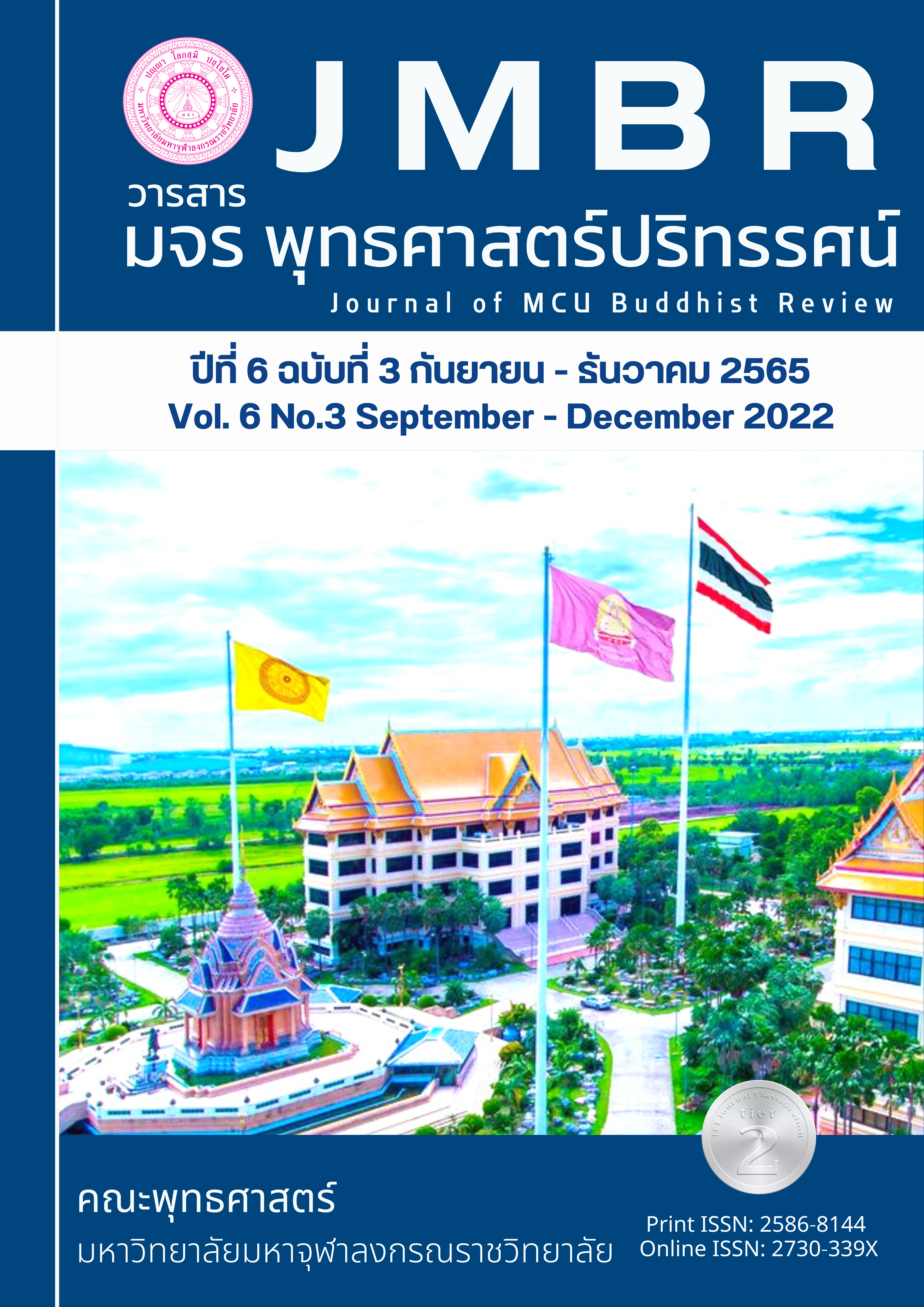การศึกษาเปรียบเทียบความเชื่อทางศาสนาเกี่ยวกับชีวิตหลังความตาย ในประเพณีของกลุ่มชาวลาวและกลุ่มชาวเขมรในจังหวัดปราจีนบุรี
Main Article Content
บทคัดย่อ
บทความนี้มีวัตถุประสงค์เพื่อเปรียบเทียบความเชื่อทางศาสนาเกี่ยวกับชีวิตหลังความตายในประเพณีของกลุ่มชาวลาวและกลุ่มชาวเขมรในจังหวัดปราจีนบุรี งานวิจัยนี้เป็นการศึกษาเชิงคุณภาพ โดยศึกษาและรวบรวมข้อมูลจากพระไตรปิฎก งานวิจัยที่เกี่ยวข้อง และสัมภาษณ์กลุ่มเป้าหมาย ผลการศึกษาพบว่า
ความเชื่อนั้นสนับสนุนให้คนเราเกิดความคิดที่จะสร้างหลักประกันความเชื่อของตนเอง จึงมีการกำหนดเกณฑ์แห่งชีวิตหลังความตายต้องมีพิธีการรองรับเพื่อให้ผู้ไปสู่โลกหน้ามีภพอยู่อาศัย โดยเฉพาะความเชื่อของกลุ่มชาวลาวและกลุ่มชาวเขมร
บุญประเพณีเกี่ยวกับชีวิตหลังความตายของกลุ่มชาวลาวและกลุ่มชาวเขมร มีรูปแบบการประกอบพิธีคล้ายกัน 2 ส่วน คือ ส่วนที่หนึ่งเป็นการเตรียมวัตถุทานเพื่อถวายพระสงฆ์แล้วอุทิศส่วนบุญให้ญาติที่เสียชีวิตไปแล้วตามคติความเชื่อในทางพระพุทธศาสนา ส่วนที่สองเป็นการทำเครื่องเซ่นไหว้เพื่อบูชาผีต่าง ๆ โดยคติที่ว่า ผีนั้น ๆ จะสามารถที่จะมาหยิบฉวยเอาวัตถุเหล่านั้นคืนเมืองเปรตได้ ส่วนนัยที่ต่างกันก็อยู่ที่รูปแบบในการประกอบพิธีอันขึ้นอยู่กับท้องถิ่นนั้น ๆ
บุญประเพณีทั้ง 2 นั้น แสดงให้ความเห็นของตัววัฒนธรรมของ 2 กลุ่ม นี้ว่ามีความเหมือนกัน ไปแนวทางเดียวกัน ตัวพิธีกรรมนี้ทำขึ้นเพื่อ 1) อุทิศผลบุญแก่ผู้ล่วงลับ 2) แสดงความกตัญญูกตเวทีต่อผู้มีพระคุณ 3) มีความเชื่อว่าท่านผู้ล่วงลับจะได้ผลบุญและมีความสุขในสุคติภูมิ มีความเชื่อไปแนวทางเดียวกันหมด ก็เพื่อเป็นการอุทิศผลให้กับผู้ล่วงลับเป็นหลักการสำคัญ
Article Details

อนุญาตภายใต้เงื่อนไข Creative Commons Attribution-NonCommercial-NoDerivatives 4.0 International License.
- บทความที่ได้รับการตีพิมพ์เป็นลิขสิทธิ์ของวารสาร มจร พุทธศาสตร์ปริทรรศน์
- ข้อความใดๆ ที่ปรากฎในบทความที่ได้รับการตีพิมพ์ในวารสาร ถือเป็นความรับผิดชอบของผู้เขียนบทความ และข้อคิดเห็นนั้นไม่ถือว่าเป็นทัศนะและความรับผิดชอบของกองบรรณาธิการวารสาร มจร พุทธศาสตร์ปริทรรศน์
เอกสารอ้างอิง
จันทร์ ไพจิตร. (2520). ประมวลพิธีมงคลไทย. กรุงเทพมหานคร: สำนักพิมพ์ไทยวัฒนาพานิช.
ทองคำ อ่อนมะสีสอน. (2535). วัดจะนานุกรมพาสาลาว. เวียงจันทน์: โรงพิมพ์เวียงจันทน์.
แปลก สนธิรักษ์. (2520). พิธีกรรมและประเพณีไทย. กรุงเทพมหานคร: สำนักพิมพ์ไทยวัฒนาพานิช.
พระประวิทย์ วิสุทฺโธ (ปานทอง). (2548). ศึกษาวิเคราะห์เรื่องเปรตในคัมภีร์ของพระพุทธศาสนาเถรวาท. วิทยานิพนธ์ศาสนศาสตรมหาบัณฑิต. บัณฑิตวิทยาลัย: มหาวิทยาลัยมหามกุฏราชวิทยาลัย.
พระธรรมกิตติวงศ์ (ทองดี สุรเตโช) ราชบัณฑิต. (2554). ชาดกในธรรมบท. กรุงเทพมหานคร, เลี่ยงเชียง.
พระมหาสุพจน์ คำน้อย. (2547). การศึกษาวิเคราะห์คำสอนเรื่องการอุทิศส่วนบุญในพุทธศาสนาเถรวาท. วิทยานิพนธ์ปริญญาศึกษาศาสตรมหาบัณฑิต. บัณฑิตวิทยาลัย:มหาวิทยาลัยธรรมศาสตร์.
พระอธิการช่วง ฐิตโสภโณ (ตั้งอยู่). (2554). ศึกษาคติทางพระพุทธศาสนาที่ปรากฏในประเพณีสารทเดือนสิบ (แซนโฎนตา) ของจังหวัดสุรินทร์. วิทยานิพนธ์พุทธศาสตรมหาบัณฑิต. บัณฑิตวิทยาลัย: มหาวิทยาลัยมหาจุฬาลงกรณราชวิทยาลัย.
มหาจุฬาลงกรณราชวิทยาลัย. (2539). พระไตรปิฎกภาษาไทย ฉบับมหาจุฬาลงกรณราชวิทยาลัย. กรุงเทพมหานคร: โรงพิมพ์มหาจุฬาลงกรณราชวิทยาลัย.
มหาจุฬาลงกรณราชวิทยาลัย. (2557). อรรถกถาพระไตรปิฎกภาษาไทย ฉบับมหาจุฬาลงกรณราชวิทยาลัย. กรุงเทพมหานคร: โรงพิมพ์มหาจุฬาลงกรณราชวิทยาลัย.
ยโสธารา ศิริภาประภากร. (2561). ประเพณีแซนโฎนตา: วัฒนธรรมประเพณีของชาวไทยเชื้อสายเขมร จังหวัดสุรินทร์. วารสารหาดใหญ่วิชาการ. 16 (2) ก.ค. - ธ.ค., 237 – 249.
ราชบัณฑิตยสถาน. (2539). พจนานุกรม ฉบับราชบัณฑิตยสถาน. กรุงเทพมหานคร: อักษรเจริญทัศน์.
สมใจ ศรีหล้า. (2550). กลุ่มชาติพันธุ์ข่า-บรู : การสร้างและการปรับเปลี่ยนอัตลักษณ์. วารสารสังคมลุ่มน้ำโขง. 1 (1) มกราคม-มีนาคม, 98.
ศูนย์มานุษยวิทยาสิรินธร (องค์การมหาชน). (2564). กลุ่มชาติพันธ์ลาวอีสาน. (ออนไลน์), แหล่งที่มา: https://www.sac.or.th/databases/ethnic-groups/ethnicGroups/62.
ศูนย์มานุษยวิทยาสิรินธร (องค์การมหาชน). (2564). กลุ่มชาติพันธุ์เขมรลือ. (ออนไลน์), แหล่งที่มา: https://www.sac.or.th/databases/ethnic-groups/ethnicGroups/160.
อนันตศักดิ์ พลแก้วเกษ. (2565). บุญข้าวสาก บุญข้าวประดับดิน: การสร้างความสัมพันธ์ในเครือญาติ ของคนอีสาน. วารสารวิชาการธรรมทรรศน์. 22(1) มกราคม-มีนาคม, 195-208.
อุดม บัวศรี. (2549). วัฒนธรรมอีสาน. ขอนแก่น: โรงพิมพ์คลังนานาวิทยา.


